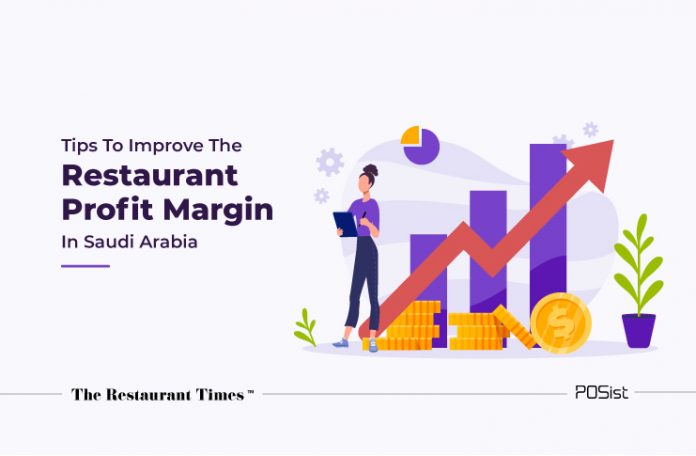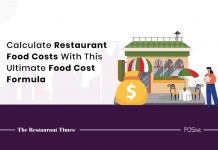One of the most common queries of restaurant owners across the world is how to measure their restaurant profit Margins and how to grow them. While there are many parameters to gauge a restaurant’s long term success, the net profit margin gives you a clear picture of whether or not it will survive in the long run. The average restaurant profit margin differs according to the different restaurant formats. Anything above 20% can be considered to be a decent restaurant profit margin. This article explains how restaurants in Saudi Arabia can calculate the net restaurant profit margin and improve it over a period of time.
A Brief About How To Calculate The Net Restaurant Profit Margin
One can calculate the net restaurant profit margin for an accounting period by dividing net income by sales.
The formula is :
Net Profit Margin = Net Income/Gross Sales x 100
Where,
Net Income = Gross Revenue – Operating Expenses
Gross Revenue is the sales revenue generated by selling food, beverages, and merchandise plus additional gains, i.e., income from a transaction that doesn’t come from regular business operations. For instance – profits from selling old restaurant furniture or kitchen equipment cannot be added to the gross revenue. Operating Expenses are the routine costs that you incur to run your restaurant. This includes the cost of ingredients, rent, equipment, depreciation, interest and taxes, repairs, wages, utilities, and maintenance.
A restaurant’s profit margin can get affected by a slight change in customer preferences or an unexpected event. Inflation, rentals, crises such as Covid-19, etc. can affect your margins noticeably. The only way restaurants can increase their profits is by increasing sales without simultaneously increasing the operating expenses. The first thing restaurateurs must do is keep track of their restaurant’s running costs.
Improve Your Restaurant Profit Margin By Focusing On These 4 Main Areas
Focusing on these four areas will help improve your restaurant operations and thus increase your restaurant profit margin.
Reduce Overall Food Costs
Increasing the restaurant sales adds up to the overall food costs, but there are some ways by which you can improve sales and still reduce food costs. Waste and theft are considered to be significant threats to a restaurant’s profits. Adopt measures to decrease the amount of food you throw away by focusing on correct portion control.
Implement standard recipe standards across the kitchen and ask your chefs to pre-measure all food items and use measuring utensils. Conduct feedback sessions with the staff asking why a particular food item has been tossed into the trash can. This will help in keeping your staff mindful of wastage. Theft of expensive foods or alcohol significantly adds up to your food costs; therefore, it is crucial to keep track of theft and pilferage.
Negotiate better prices with suppliers. You can either keep track of your most ordered food items and ask for discounts or procure raw materials directly from farmers or producers to avoid having to give middlemen and wholesalers’ their cut. Sourcing food items locally will also help in considerably cutting down the freight expenses and food costs.
Pricing and designing the menu the right way will help in cutting down the food costs marginally. Several factors must be taken into consideration during menu pricing, such as direct costs, indirect costs, volatile costs, etc.
Try Decreasing Overheads
While reducing fixed costs such as rent can be tough, you can focus on other variables like salaries, utilities, and wastage.
Hire qualified staff and provide them with proper training to be efficient and more productive. Incentivizing employees will also ensure happy staff, high performance, and increased loyalty, which in turn leads to reduced hiring and training costs, and more profits. Similarly, you can train your staff to multi-task.
Restaurants generate high utility bills. Apart from leveraging energy-efficient equipment, restaurants can replace high-watt electrical equipment with energy-saving or sensor-enabled alternatives to save on high bills.
Wastage in the kitchen is unavoidable but must be controlled to combat the excessive costs. Employ a POS system that comes with comprehensive recipe management and inventory management features. This will ensure that all the dishes are prepared by following a uniform procedure and that the stock is utilized appropriately, thereby reducing the loss of raw materials.
Leverage Technology
Installing a robust restaurant management system can help reduce costs and improve the overall restaurant’s profit margins. A POS system greatly helps in:
- Tracking inventory and setting reordering schedules to avoid thefts
- Reducing waste from spoilage and ordering mistakes
- Increasing table turnover rates
- Monitoring sales to keep the inventory levels in order
- Identifying trends such as high-margin items or best-selling items, that help in redesigning your menu accordingly
- Managing employee hours and payroll
- Increasing table turnover rates and staff efficiency
Increase The Sales
In order to increase the restaurant profit margin, there is a dire need to improve overall sales. You can increase your restaurant sales by getting more customers or selling more to the already existing customer base. Leverage restaurant technology and use different online and offline mediums to promote your restaurant and attract new and repeat customers.
Utilizing these tips will help restaurants in Saudi Arabia to control the overall operating expenses, control hidden costs, and increase the overall restaurant’s profitability exponentially.



















